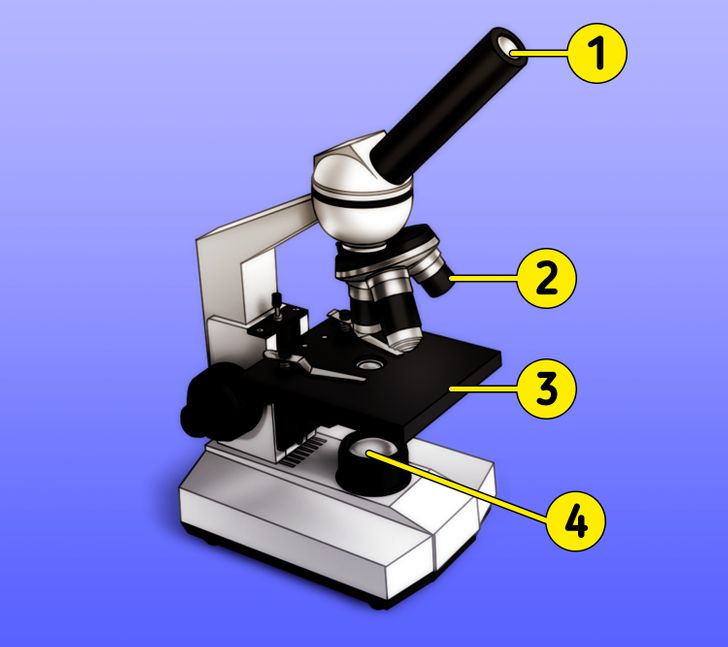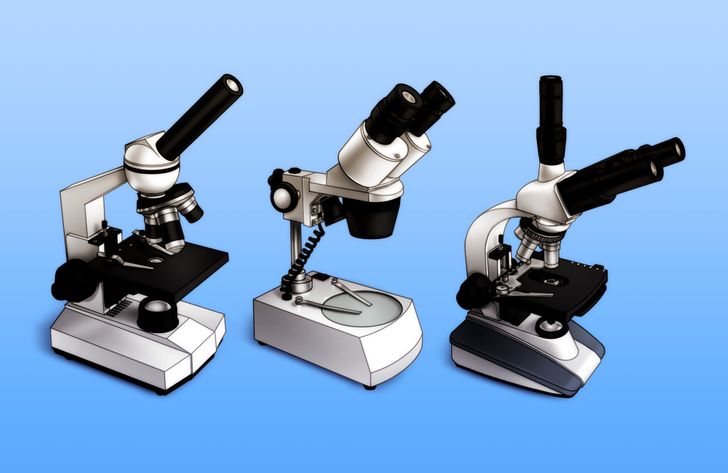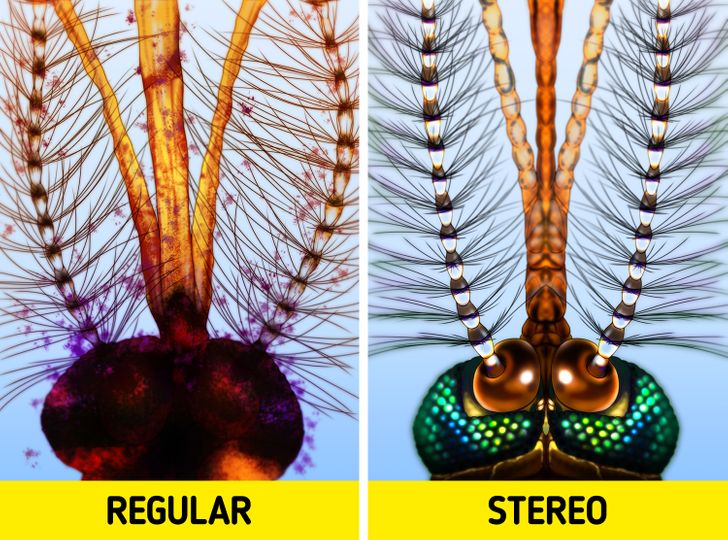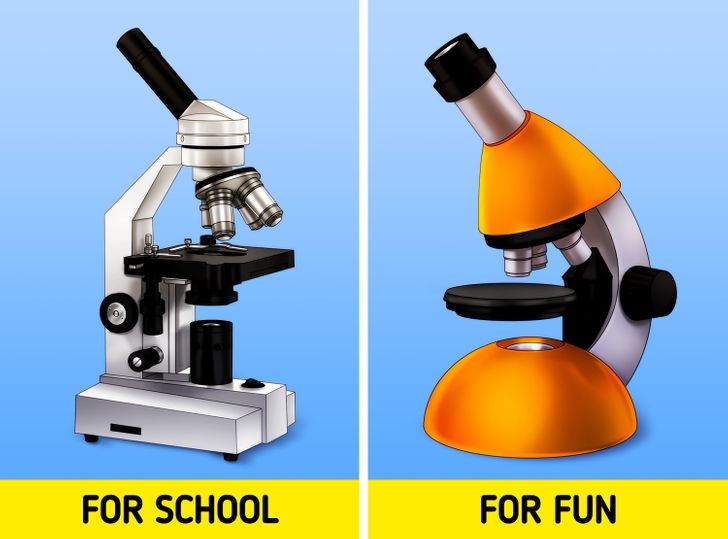How to Choose a Microscope
It’s pretty difficult for a regular person to navigate the different types of microscopes, even if we are talking about models for children. They say price determines quality, but chances are that you will overpay for features you don’t need.
5-Minute Crafts would like to give you some tips on how to make the right choice when buying a microscope.
Microscope parts

Usually, a microscope consists of a stand with the following main parts:
1. An eyepiece, which allows a person to view an image of the object that is under the microscope. The eyepiece contains lenses: the one that is closest to the eye is called the eye lens, the one on the opposite side of the eyepiece is called the field lens. The eyepiece allows you to adjust the magnified image of the object received by the lens so you can see it.
2. An objective lens, which is a complex optical system in the form of a tube, consisting of fixed glass lenses. The task of each objective lens is to magnify the projection of the image that is received from the surface of the first lens. Each objective lens has its own level of magnification. But a microscope can have several objective lenses, which are replaced by a simple turn of the revolver to which they are attached. There are also models that allow you to change objective lenses. Thus, the objective lenses can be single, interchangeable, or fixed on a revolving nose piece. Lenses are also divided by their ability to correct the image. Achromatic lenses, for example, partially remove color distortion, apochromatic lenses remove color distortion completely, and plan lenses provide a sharp image across the entire field of view.
3. A microscope stage, that holds your specimen in place and on which the objective lens is directed. The stage may have clips that secure a glass with the specimen. On some models, the height and position of the stage relative to the objective lens and light source can be adjusted.
4. An illumination system that directs light to illuminate your specimen. It can be an LED light, a lamp, any other light source, or just a mirror that uses light rays from an external source. The illumination system also includes a condenser that collects rays from the light source and directs them toward the specimen. Some models may have an aperture — a hole that controls the amount of light passing through the observed object.
The models of simple optical microscopes can consist of an eyepiece, one or more objective lenses with different levels of magnification, a stage with clips and glasses, and an illumination system in the form of a mirror under the stage.
Types of microscope heads

- Monocular microscopes are equipped with one tube through which a person examines an enlarged image of a specimen. Models with this head are more affordable, and people buy them for home experiments and school labs most often.
- Binocular microscopes allow you to look through the eyepieces with your both eyes. Thanks to this, your eyes don’t feel tired during long-term observation, which occurs when working with a monocular microscope. Besides, some models of a binocular microscope are stereo microscopes, which allow viewing objects in 3D.
- Trinocular microscopes, unlike binocular microscopes, allow not only observing an object with both eyes, it also has an additional tube where you can install a camera in order to take a photo of the observed specimen or display it on a PC monitor screen.
Magnification

The microscope magnifies the image of an object thanks to the objective lenses and the eyepiece lenses. If you multiply the magnification of the eyepiece by the magnification of the objective lens, you’ll get the magnification of the microscope. For example: a regular eyepiece magnification strength is 10x and the objective lens is 4x. Multiply those together and the total magnification is 40x. This is exactly as many times as the microscope will magnify the image of the object that you see when looking through the eyepiece.
Biological microscopes are often equipped with 3 to 4 objective lenses with different levels of magnification (usually 4x, 10x, 40x, and 100x magnifications).
So, if the eyepiece magnification is 10x, this microscope will be able to provide magnification from 40x to 1000x, depending on which objective lens you are observing the object through. High magnification models also have knobs for coarse and fine focus on the object.
How do you know what magnification you need? The picture above shows what human blood cells look like under a microscope at different magnifications. They look just like dots in the upper pictures. But in the lower ones, you can distinguish between erythrocytes and leukocytes.
If you work with a stereo microscope, you can quickly switch between different magnifications or zoom into an image within the scope of the device’s magnification. On the other hand, stereo microscopes provide a rather low magnification: you won’t be able to see blood cells, but you can see the structure of an insect’s body or a skillful diamond cut.
Immersion

To enhance the brightness of the image and expand the magnification limit, immersion is used — a liquid is injected between the microscope objective lens and the specimen, provided that the objective lens is designed for this work.
So, the system in which the space between the first lens and the specimen is filled with a liquid is called an immersion optical system, and the liquid used is called immersion. The immersion oils recommended by the lens manufacturer are the best option for this. It’s best to order them in specialized stores that sell optical instruments.
Types of microscopes

There are different types of microscopes. A lot depends on the resolution of the device, which affects the quality and clarity of the image. In other words, each instrument has a limited ability to create a clear image of 2 separate points of an object that are close to each other. The minimum distance at which the 2 points are clearly distinguishable as separate is called the microscope resolution limit. It is associated with the wavelength of light that illuminates the specimen, and with the ability of the optical system of the microscope.
So, optical or light microscopes, for example, allow you to study the microcosm, while electron microscopes will help you look even deeper into it, since their resolution is thousands of times higher than the resolution of a regular light microscope. The fact is that in the first case, light is used to create an enlarged image, and in the second case, an electron beam is used, due to which it’s possible to magnify an image 50 million times. There are also more sophisticated devices. For example, an X-ray microscope helps you study extremely small objects, as well as look inside them if they are opaque to light rays and electrons.
Thus, for schoolwork or amateur research, you will find the right model among optical microscopes that are capable of 1,000x magnification. While an electron microscope is a huge device that is used for research in scientific institutions.
It’s worth mentioning a stereo microscope, which belongs to optical microscopes and provides a 3D image of an object. This device has a binocular head, a system for changing magnifications, and an objective lens. It doesn’t provide high magnification but is suitable for those who want to study large objects, like insects, stones, flowers, or minerals. The microscope also has an important feature. It allows you to observe a living object, while a regular optical microscope requires the cutting or flattening an object to obtain a section for study.
Microscope prices

Bright plastic microscopes are cheap and can be a great choice for a child, but you should keep in mind that they are just toys for kids, and have nothing to do with the world of science. You can see cells of onions and large protozoa in a drop of water, but this microscope is limited in its capabilities and it won’t last for long.
A metal microscope with multiple lenses costs about $100 and is a great choice for a student.
If microscopy is your favorite hobby, then it’s worth investing in a compound metal microscope with a decent collection of lenses, a trinocular head, a camera port, and other accessories.
A guide that will help you choose a microscope
- Make a list of tasks that you plan to solve with the microscope, and choose a model within your budget according to that list.
- Determine what magnification the microscope should have and whether you need to work with several objective lenses in different magnifications.
- If you need a microscope with multiple objective lenses, find out if they come with the device or if you need to buy them separately.
- If you have a choice, go for high-quality optics: opt for glass instead of plastic.
- Check whether the accessories you need come with the microscope or whether you need to order them separately.
- If the microscope you are looking for is out of your budget, consider buying a second-hand device. You may have to buy new objective lenses, but the overall price may be lower than the cost of a similar device that’s brand new.